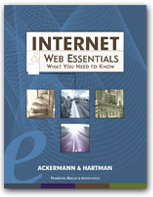The Internet is, by definition, a collection of networks throughout the world
that agree to communicate using specific telecommunications protocols. But
this definition doesn’t describe what makes the Internet so exciting.
The Internet can also be viewed in terms of the people who use it and the
ways they communicate with each other to share information and ideas. It is
also a place for people to do research, conduct business, and find information
that may enrich their daily lives. The major difference between the Internet
and other media, such as television, is that it is interactive and provides
immediate feedback. We define the World Wide Web to be the collection of information
available through the Internet.
While many people primarily use the Internet for communicating, either
one-on-one or in groups, the World Wide Web is gaining popularity around the
world. Since the advent of graphical browsers like Netscape Navigator and
Microsoft Internet Explorer, the hypertext environment on the Web has made
it easy for people to access information by simply clicking on a hyperlink.
These hyperlinks can connect the user to text files, programs, charts, graphical
images, and digitized video and audio files. The possibilities seem endless,
and the path you take is your own choice. A Uniform Resource Locator, or URL,
represents each hyperlink. Web browsers use these URLs to specify the type
of Internet service or protocol needed and the location of the item. For example,
the URL for the Web page "POPClocks" (at the U.S. Census Bureau’s
Web site) is http://www.census.gov/main/www/popclock.html. The protocol
or service in this case is HTTP, or Hypertext Transfer Protocol, and a Web
browser using that URL would contact the Internet site www.census.gov
and access the file popclock.html in the directory named www.
There are services and tools on the Internet that help you access information,
communicate, search for information, and make information available on the
World Wide Web. There are services for asynchronous group communication, such
as email discussion groups and Usenet newsgroups, as well as services for
one-on-one communication. There is also the opportunity to be involved with
synchronous communication through chat groups.
The amount of information on the World Wide Web is growing at such a
rate that it is a challenge to know how to find what you need. To help you
find resources, a number of search services and tools have been developed.
There are two major types of search tools: search engines and directories.
The Internet developed through projects sponsored by governments in the
United States and elsewhere to allow researchers to communicate with each
other and share results. The initial work began in the late 1960s. There was
a tremendous growth both in the number of networks communicating according
to the Internet protocols and the number of users accessing the Internet during
the 1980s and ‘90s. There is no central controlling authority that governs
the activities on the Internet. However, a number of local laws, acceptable
use policies, codes of ethics, and information literacy guidelines are being
adopted so that users can use the Internet in a productive and creative way.
Summary | Terms | Exercises
| FYIs

